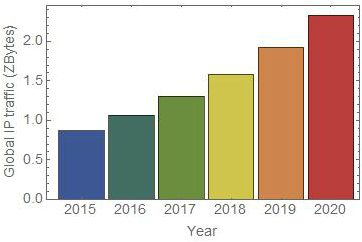
Cisco predicts that the global traffic crossing the internet will increase with a compound annual growth rate (CAGR) of 22% during 2015-2020. [Source: Cisco Global Cloud Index: Forecast and Methodology, 2015–2020.]
Increasing data traffic A grand challenge...
Data traffic is expected to grow exponentially in the near future due to cloud computing, the internet of things, and 5G wireless. If maintained over long periods of time, this traffic increase can cause severe congestion in the fiber-optic internet backbone network, an event dubbed ‘capacity crunch.’

Simulation block diagram of a long-haul coherent optical communications system using mode-division multiplexing over multimode fibers (MMFs) . A single spatial super-channel is depicted for simplicity. The optical modulator (MO) and the coherent receiver front-end (Rx) are shown as insets (in green). Symbols: SLD =semiconductor laser diode, MO=modulator, CPL=coupler, PRSS=pseudo-random symbol sequence generator, QM= quadrature modulator, PBC=polarization beam combiner, PCTR=polarization controller, MMF=multimode fiber, OA=optical amplifier, MMUX=mode multiplexer, λ-MUX=WDM multiplexer, MDMUX=mode demultiplexer, λ-DMUX=WDM demultiplexer, Rx=coherent optical receiver, ADC=analog-to-digital converter, DSP=digital signal processing).
Link capacity optimization A promising solution...
It is possible to maximize the capacity of optical communications systems by using new optical fiber types that can accommodate future data traffic in a cost-efficient way.

